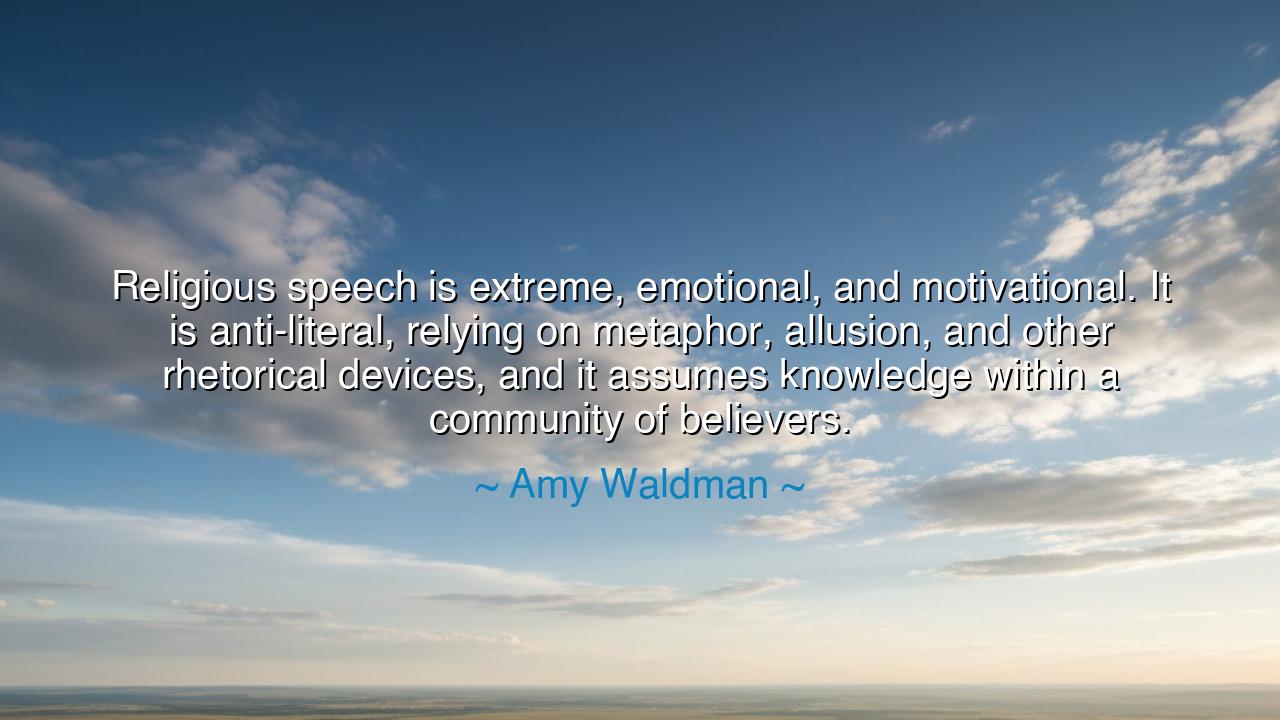
Religious speech is extreme, emotional, and motivational. It is
Religious speech is extreme, emotional, and motivational. It is anti-literal, relying on metaphor, allusion, and other rhetorical devices, and it assumes knowledge within a community of believers.






The words of Amy Waldman shimmer with insight into the mysterious power of human faith: “Religious speech is extreme, emotional, and motivational. It is anti-literal, relying on metaphor, allusion, and other rhetorical devices, and it assumes knowledge within a community of believers.” In this reflection, Waldman reveals the sacred language of the soul—the way religion speaks not to the intellect alone, but to the spirit that hungers for meaning. She reminds us that religious speech does not exist to describe the world as science does, but to transform it—to lift the heart beyond what is seen, and to awaken the divine imagination that sleeps within all humankind.
Since the dawn of civilization, people have turned to symbol and metaphor to grasp the ungraspable. The gods of Egypt, the hymns of India, the psalms of David—all were clothed in language rich with allusion and emotion. The ancients knew that truth, when wrapped in poetry, enters deeper into the soul than any argument could. When the Hebrews sang of God as a shepherd, when Christ spoke of seeds and lamps, when Muhammad declared the Qur’an as light—these were not literal claims, but metaphors of the eternal, bridges between heaven and earth. In every faith, the sacred tongue transcends logic, for it speaks to what lies beyond reason: the longing for union with the Infinite.
Waldman’s words also remind us that religious language is communal, woven with the shared memory of those who believe. To the outsider, a sermon or chant may sound strange, even “extreme,” but to the believer, it resonates with ancestral meaning. The phrase “body of Christ,” for example, to the uninitiated may appear grotesque or incomprehensible, yet to Christians it embodies the profound mystery of sacrifice and love. Likewise, the cry “Allahu Akbar” may be misunderstood as a political slogan, yet within Islam it is a sacred declaration—God is greater than all. Religious speech thus depends on a shared faith, a language of the heart spoken by those who see the same invisible light.
To call such speech “emotional,” as Waldman does, is no criticism, but a recognition of its sacred fire. Religion is not born of cold analysis, but of yearning, awe, and reverence. When Moses trembled before the burning bush, when the Buddha sat in silence beneath the Bodhi tree, when the prophets cried out against injustice—their words were not calculated essays, but eruptions of divine passion. The extreme tone of religious expression mirrors the intensity of the experiences that inspire it. Those who have felt the weight of eternity upon their hearts cannot speak softly; their voices thunder because their souls have seen beyond the veil.
History offers countless examples of this sacred rhetoric shaping the destiny of nations. When Martin Luther King Jr. stood on the steps of the Lincoln Memorial and declared, “I have a dream,” he was not giving a political lecture; he was preaching a modern psalm. His speech drew upon biblical rhythm, prophetic imagery, and a moral fervor that stirred millions to rise against injustice. Like the prophets of old, King spoke the language of faith to summon the conscience of the world. His words were metaphor and music, flame and truth. They revealed what Waldman means by “motivational”—for religious speech moves men to action, not by argument, but by awakening their deepest convictions.
The anti-literal nature of religious speech is also what gives it timelessness. The literal fades with context; the symbolic endures. The parable of the Good Samaritan, though told two millennia ago, still teaches compassion because its imagery transcends culture and time. The lotus that blooms in Buddhist scripture still whispers of enlightenment to seekers in every age. Literal minds may ask, “Did it happen exactly this way?” But the wise answer, “It happens in us, every day.” Thus, Waldman calls us to see that religious truth is not measured by fact but by transformation—by what it awakens in the human heart.
From this, a great lesson unfolds: learn to hear the sacred beneath the words. Do not mock what you do not understand, nor take too literally what was meant as mystery. When you read scripture, listen not only with the mind but with the spirit; when you hear a believer speak, look for the eternal meaning hidden in the metaphor. To live wisely is to interpret with reverence—to know that the symbols of faith are not chains of superstition, but doorways to transcendence.
Thus, the wisdom of Amy Waldman becomes clear: that religious speech, though often fierce and filled with emotion, is the heartbeat of humanity’s dialogue with the divine. It speaks in parables because truth too vast for language must be clothed in story; it speaks with passion because only passion can reach heaven. It binds believers together in shared mystery, and it drives them toward goodness and hope. So let us honor the poetry of the sacred, for in its rhythms we hear not only the cry of the human soul—but the whisper of God answering back.






AAdministratorAdministrator
Welcome, honored guests. Please leave a comment, we will respond soon